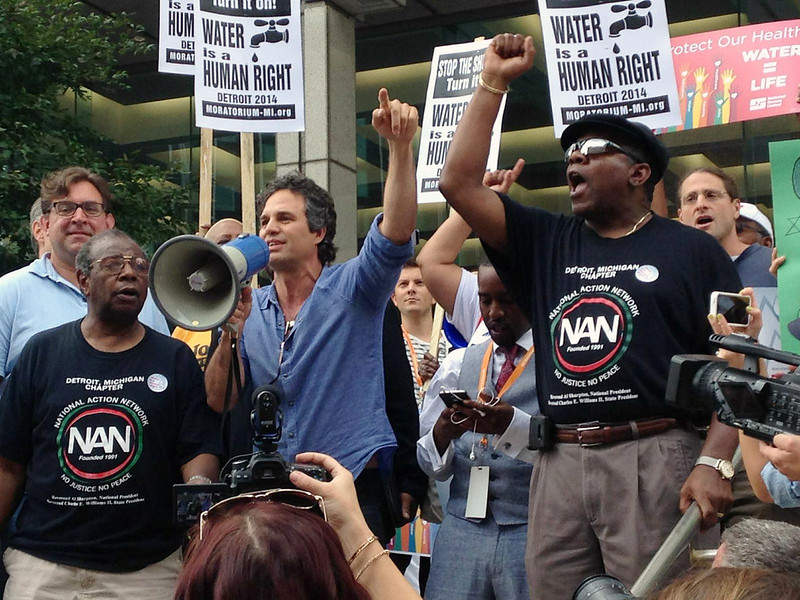Our days now are clouded with uncertainty. How long will the COVID-19 crisis last? What immediate health effects and long-term economic damage will we experience? What’s the best protocol for staying safe and healthy?
On that last front, we know one thing for sure: We need to wash our hands well and often. And for that we need clean, running water.
But so far the federal legislative responses to the novel coronavirus crisis have not included financial support for water utilities, most of which are public agencies. And there’s been no federal mandate to prevent water shutoffs for households unable to pay their bills.
“We’ve known that water is a priority, but it’s just not the top priority,” says David Zielonka, communications manager for the National Association of Clean Water Agencies, which represents public wastewater and stormwater agencies. “There’s been incentive and motivation on both sides to include it [in upcoming legislation], but getting it into the final package hasn’t happened yet.”
Economic Pressures
Water utilities have had to quickly adapt to make sure their vital services keep running, even if staff are sick or otherwise sidelined by the virus. In California the Mercury News reported that a desalination plant in Carlsbad, which supplies drinking water to San Diego, is now housing its 10 most critical employees on site so they remain healthy.
Ensuring a safe, secure & reliable water supply in San Diego County at the Carlsbad #Desalination Plant during #COVID19 pandemic. Ten workers “self-isolate” for 21 days, working 12-hour shifts to keep the water flowing. https://t.co/XVW2bYJ5fJ #cawater #coronavirus #PublicService pic.twitter.com/bGqLDeMLB6
— San Diego County Water Authority (@sdcwa) March 24, 2020
Other agencies have made arrangements to provide beds and food for workers if they need to live at treatment plants. Some are even calling back retired employees to bolster reserves. A survey of industry leaders by American Water Works Association found that nearly three-quarters of utilities expect to face challenges from absentee workers due to illness. Smaller water utilities, with just a few workers, are even more at risk if critical staff become unavailable.
But that’s not the only challenge.
With many industries, shops, restaurants and other businesses ground to a halt, water utilities now anticipate a precipitous decline in revenue, which will also reduce funds available for their already tight operating budgets. Zielonka says the National Association of Clean Water Agencies’ members are projecting losses ranging from 20% to 40%.
“These utilities are all publicly owned and they don’t have vast private resources in terms of stock buybacks or other things they can do to recoup this lost revenue,” says Nathan Gardner-Andrews, the general counsel and chief advocacy officer for the National Association of Clean Water Agencies. “They’re basically stuck.”
Drinking-water and wastewater services are usually billed based on the volume of water delivered — it’s revenue based on usage. But the costs for the industry — to maintain the infrastructure and keep treatment plants running — are fixed. When usage falls, costs remain the same, and the utility gets pinched.
The utilities are, of course, not the only ones being hit with economic losses. Some 17 million Americans have filed for unemployment in the past four weeks. For some families, that may mean an inability to pay their water bills. That’s more lost revenue for water agencies and a potential life-and-death health risk for residents if utilities enforce water shutoffs for delinquent payments.
Some utilities, like the New Orleans Sewerage and Water Board, have chosen not to shut off water connections in light of the pandemic. At least 12 states have mandated that shutoffs cease during the health emergency, and the governors of California, Michigan, Ohio and Wisconsin have ordered that water service be restored to those without it. But there’s no federal order, and it’s likely that millions of Americans are still at risk of losing service because of dire financial straits.
Longstanding Problems
This shouldn’t come as a surprise.
An “affordability gap” has been growing in America’s water system over the past two decades, says Gardner-Andrews.
Keeping up with replacing and repairing aging infrastructure, which is 100 years old in some parts of the country, has significantly added to the costs of water services that have been passed on to ratepayers. Between 2000 and 2015, the cost of water and wastewater services rose more than 40% in some major U.S. cities. Rural communities, which lack economies of scale, often pay twice as much for water as urban residents.
As a result an estimated 12% of U.S. households find their water bills unaffordable, according to a 2017 study by researchers from Michigan State University — and that was before millions lost their jobs in the last few weeks. Meanwhile, federal assistance for water infrastructure has fallen 77% since its peak in 1977, but the need is greater than ever.

The American Water Works Association estimated that we’ll need $1 trillion over the next 25 years to upgrade our aging water infrastructure.
The current crisis may help shine a light on this affordability gap, but it also reveals another longstanding problem that we can’t delay addressing: Around 2 million people in the United States don’t have running water and adequate plumbing. For example, about 40% of the Navajo Nation lacks running water, which could put many residents at risk during the COVID-19 pandemic.
Political Pressure
In the months ahead, mounting financial losses for water utilities will likely mean rate increases that will become unsustainable for more and more poorer households, says Gardner-Andrews.
“How bad it is, and the level of pain they pass onto their ratepayers, will in a large part depend on what financial assistance, if any, comes from federal and state governments,” he says.
His organization is asking Congress to direct $12.5 billion in aid for water utilities in the next stimulus bill to offset the loss of revenue, provide assistance for those who can’t pay, and keep water rates from rising. Other nonprofits are calling for a national moratorium on water shutoffs and more support for low-income affordability programs.
Their concerns are supported by at least 80 members of Congress who sent a letter to House and Senate leaderships asking for legislation to “prioritize water infrastructure funding to local water providers and provide assistance to ensure that no American goes without water service due to an inability to pay during this pandemic.”
Other industry leaders are lending their voices in support of addressing shortfalls in access and affordability.
“We have an opportunity now to deliver on the human right to water by including urgent infrastructure upgrades and ratepayer protections in the coronavirus relief packages currently being negotiated,” wrote Peter Gleick, Heather Cooley and Laura Feinstein, researchers with the global water think-tank the Pacific Institute, in an op-ed in the Hill. “After decades of deferred maintenance and disinvestment, it is time to shore up the systems that keep our communities healthy and ensure even the most vulnerable among us have access to safe water and sanitation.”
Many groups, including House Democrats, have pushed for a big infrastructure package that would address decades of funding shortfalls, including $25 billion for drinking water, and $50 billion for wastewater and other clean-water projects.
“The next COVID-19 stimulus package provides an opportunity to invest in ways that create lots of jobs and finally begin to provide the level of resources that are needed to make sure no one is drinking polluted water,” says Scott Faber, senior vice-president of government affairs at the nonprofit Environmental Working Group.
But it’s increasingly looking like the next stimulus package may bypass water issues yet again. When asked about an infrastructure package, Speaker of the House Nancy Pelosi told E&E News that it’s not off the table, “But what is on the table is more funding for the immediate needs that people have.” It’s not clear yet if that includes help for those who can’t afford their water bills.
![]()



3 thoughts on “Pandemic Shines a Light on Critical Water Issues — Will Congress Fund Solutions?”
Comments are closed.